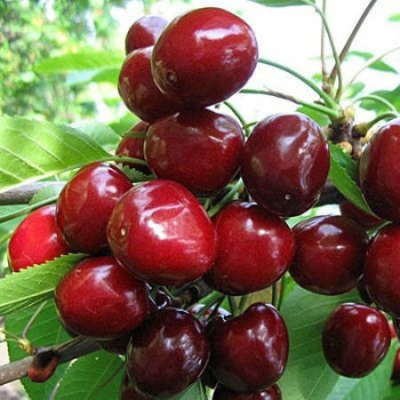
- Fruit shape: oval
- Authors: P.I.C.O. Summerland (International plant selection, Canada)
- Growth type: medium-sized
- Appointment: universal
- Yield: high
- Tree height, m: up to 3.5
- Fruit size: large
- Fruit weight, g: 10-12
- Fruit color: deep red
- Pulp color : Red
Sweet cherry Staccato - the best variety of late ripening, attracting the attention of gardeners with high marketable qualities and juiciness of fruits. Read more about the characteristics and features of growing sweet cherries in the article.
Breeding history
Breeders from Canada were engaged in the breeding of the Staccato variety, who managed to obtain a winter-hardy plant, which instantly became in demand in many regions of the world and the country. The tree tolerates frost well, has a strong immunity and high yields.
Description of the variety
Cherry Staccato is the best variety that belongs to the category of late ripening plants. Specifications:
- height - up to 3.5 meters;
- flowers are medium in size, white;
- leaves are large, bright green.
There are small notches at the end of each leaf blade.
Fruit characteristics
Sweet cherry forms large fruits with an average weight of up to 12 g. Characteristics of berries:
- shape - oval;
- skin color - dark red;
- density - medium.
Staccato fruits have good transportability, so the berries do not deform or crack during transportation.
Taste qualities
Tasting assessment of Staccato berries - 4.8 points out of 5. The fruits are distinguished by a dessert taste, the flesh is tender, juicy, with a rich red hue. The round bone is difficult to separate.
Ripening and fruiting
Sweet cherry begins to bear fruit 3 years after planting. Ripening occurs closer to the first decade of August and depends on climatic conditions. The berries can be stored in the refrigerator for up to 2 weeks.

Yield
The average yield per tree is up to 20-30 kg per season.
Self-fertility and the need for pollinators
The variety belongs to the group of self-fertile plants, so it does not need pollinators. However, to increase yields, it is worth planting cherries next to other varieties.
Growing and caring
Cherry Staccato is an unpretentious variety that can survive in any conditions. But in order to ensure quick survival and achieve high rates of tree yield, you should take care of choosing a place for planting a seedling and care.
Basic recommendations for disembarkation.
- It is better to plant cherries in the spring season, when the snow melts and the weather is warm. In the southern regions, landing is possible in the fall.
- It is recommended to choose areas illuminated by the sun, where there are no drafts and stagnant water. Otherwise, it will be necessary to provide for wind protection and a drainage system so that the plant does not rot.
- When buying a seedling, it is worth giving preference to two-year-old specimens with a strengthened root system and the absence of defects in the form of cracks and rot.
Cherry planting scheme is as follows.
- 10-14 days before disembarkation, holes are dug in the ground up to 40-50 cm deep and 50 cm in diameter.
- Organic fertilizers are poured at the bottom of the hole, loosened the earth and put a peg that will stick out above the ground by 30-40 cm.
- After 2 weeks, the seedlings are placed in the prepared pits, gently spreading the roots. The remaining space is covered with soil and rammed, the trunk is tied to a peg.
At the end, the soil is watered abundantly. The next step is leaving. The main components of the process include the following activities.
- Watering. It is recommended to water abundantly only young plants that need water for active growth and crown formation. During the first month after planting, cherries are watered 2 times a week. Volume at a time - 1 bucket. In drought, watering is recommended to increase to 2 buckets.
- Pruning. An obligatory procedure for fruit crops, with the help of which it is possible to distribute the strength of the plant and direct most of it to the formation of berries. Pruning is done in the spring and fall to remove long, dry and diseased shoots.
- Fertilizer. The variety is not picky about frequent feeding. Therefore, it is better to fertilize the soil during the growing season and flowering. Additionally, you can mulch the trunk circle to retain moisture.
Loosening and weeding of weeds are also mandatory care steps that prevent the development of diseases and saturate the roots with oxygen.




Disease and pest resistance
The staccato is distinguished by strong immunity, so pests and diseases are not terrible for the tree. However, gardeners recommend, for prevention purposes, to treat the plant before flowering and fruiting.

Requirements for soil and climatic conditions
The variety easily withstands even the most severe frosts and is drought-resistant. This feature made sweet cherries in demand in many regions of the country.
































































